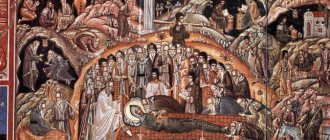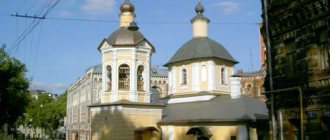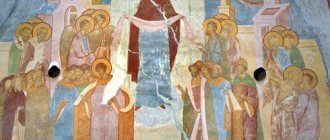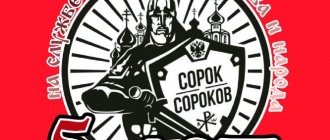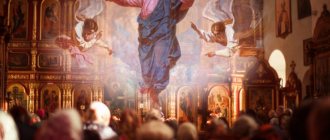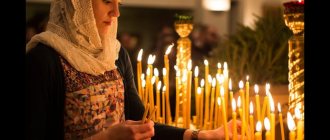On Tuesday, October 8 , Orthodox Christians celebrate the Day of Remembrance of St. Sergius of Radonezh . Read more about this holiday in the material of the Federal News Agency .
Hegumen Sergius of Radonezh, the wonderworker of all Russia, who lived during the years of the Mongol-Tatar yoke, reposed in God on October 8, 1392 (September 25 - old style). Since the 15th century, the Russian Orthodox Church has venerated this founder of several monasteries, including the Trinity-Sergius Lavra near Moscow, as venerables - this is a special category of saints who pleased God with their monastic feats. Sergius of Radonezh is also considered the greatest ascetic of the Russian land and patron of students.
Life of Sergius of Radonezh
The first to write about the life of Sergius of Radonezh was his disciple Epiphanius the Wise , who was later also canonized. This “Life” tells about the miracles that happened to Sergius of Radonezh, and does not say when the saint was born. The date of his birth is indicated in the life compiled by Archbishop Nikon - May 3, 1319. But in the works of other researchers, other dates of birth of Sergius of Radonezh are given, and therefore it is not known for certain at what age he died. According to one version - at 70 years old, according to another - at 78.
Sergius of Radonezh was born in the village of Varnitsa near Rostov “from noble and faithful parents” Cyril and Mary . From birth he was a special child - while still in the womb, he cried out three times during the liturgy, refused to take his mother’s breast on fast days and did not accept milk from the nurse...
At baptism the boy was given the name Bartholomew. When the boy was seven years old, he and his brothers Stefan and Peter were sent to learn to read and write. The brothers studied successfully, but Bartholomew did not succeed, for which he was punished by the teacher and scolded by the teacher. And then the youth began to “pray to God with tears,” writes Epiphanius the Wise. And one day young Bartholomew met a mysterious old man in a field near an oak tree, to whom he told about his problems with his studies, and after praying together and eating the holy prosphora, learning began to come easily to him, and he began to know reading and writing better than his brothers and all his peers. This event was depicted by the artist Mikhail Nesterov in his painting “Vision to the Youth Bartholomew.”
wikipedia.org/
Before reaching the age of 12, Bartholomew began to observe strict fasting and pray at night. Around the same time, his parents became poor and the family had to move to the city of Radonezh. Bartholomew dreamed of accepting the monastic feat; his parents did not object, but asked him to wait for their death. When this happened, Bartholomew gave his share of the inheritance to his younger brother and, together with his elder, went to live in the desert. After a long search, the brothers “finally came to a deserted place, deep in the forest, where there was water,” writes Epiphanius. They built a cell there, and then built a small church, which they consecrated in the name of the Holy Trinity.
Stefan lived for a short time in the desert with his brother and went to a monastery, where life was not so difficult and harsh. Left alone, Bartholomew called Abbot Mitrofan and received monastic tonsure from him with the name Sergius. After some time, monastic brethren began to settle around him. It is believed that the Trinity Lavra of St. Sergius was founded in 1342. Sergius became its second abbot (the first was Mitrofan) and presbyter. He forbade the monks to beg for alms and decreed that the monks should live by their labor, setting an example for them in this.
wikipedia.org/
In addition to the Trinity-Sergius Lavra, the monk founded several more monasteries. “With quiet and meek words” Sergius reconciled the warring princes, persuading them to submit to Prince Dmitry Ioannovich . Thanks to this, they managed to win the Battle of Kulikovo, for which the prince received the nickname Dmitry Donskoy . On the eve of the battle, he came to Elder Sergius, whom he trusted very much, and asked whether he should fight against the Tatar horde, which Mamai .
“You should, sir, take care of the glorious Christian flock entrusted to you by God. Go against the godless, and if God helps you, you will win and return unharmed to your fatherland with great honor,” Sergius of Radonezh answered the prince.
And when the Russian soldiers who set out on the campaign saw the numerous and fierce Tatar army and stopped, wondering what to do, a messenger appeared with a message from the saint, which said:
“Without any doubt, sir, boldly oppose their ferocity, without being at all afraid, God will definitely help you.”
Six months in advance, Sergius of Radonezh foresaw his death and notified the monks about it.
“Take heed to yourselves, brothers. First have the fear of God, spiritual purity and unfeigned love,” the saint instructed before his death.
wikipedia.org/
The Monk Sergius died in 1392, 30 years later his relics were found, which are now in the Trinity Cathedral of the Holy Trinity Lavra of Sergius. In 1919, the Bolsheviks uncovered the relics of the saint and kept them in the museum until 1946, after which they returned them to the church.
Through the prayers of Sergius of Radonezh, many miracles happened. But as Patriarch Kirill noted in one of his interviews, “the meaning of miracles is not in the very fact of violating the laws of nature, but in confirming man’s closeness to God, to whom everything is possible.”
“The main miracle of St. Sergius is himself,” emphasized the Primate of the Russian Orthodox Church.
What church holiday is October 8
On this date, the Orthodox Church celebrates the day of remembrance of the ascetic of the Russian land Sergius of Radonezh, who was canonized for his righteous deeds. He is the founder of the Trinity Monastery in Moscow and the reformer of monasticism in the northern regions of the Russian land.
The holiday is marked by special signs; in addition, there are a number of recommendations for housekeeping. For example, from this day it is allowed to start making preparations from cabbage, but you should postpone the slaughter of chickens and cooking food from their meat.
Sergius of Radonezh, who had the name Bartholomew before his baptism, is still revered by the Russian Orthodox Church as a saint today.
Folk traditions and signs
The people called the day of the death of Sergius of Radonezh a skit. On this day, it was customary for the whole family to ferment cabbage in wooden barrels, which were previously fumigated with thyme and rubbed with garlic, and several fragrant sprigs of juniper were placed at the bottom. These simple secrets gave sauerkraut an extraordinary taste and aroma.
In addition, in Rus', it was customary for Sergius of Radonezh to prepare dishes from chicken and eggs, because the monk was considered the guardian of this poultry.
Be sure to attend church services in the morning to honor the memory of the saint. They prayed at his icons for happiness, good luck in all matters, in work and study. They also asked for health - both physical and spiritual.
And by the weather on October 8, they judged when winter would begin: if the first snow fell on that day, then the establishment of winter was expected on November 21 or 22.
Sergius of Radonezh - why him?
Estimated reading time: less than a minute.
What did this saint do if he was already revered during his lifetime, and later generations awarded him the high title of “abbot of all Rus'”? Is the monastic path of Sergius different from the feat of the early monks, and if so, what exactly is its uniqueness? And, finally, what influence did the venerable saint of God have on the culture of Northeast Rus'?
The saint lived in the 14th century - during the years of the Mongol-Tatar yoke. Russian lands survived the Horde raid in different ways. And if the European part, better known today as Ukraine and Belarus, had practically gotten rid of the political dictates of the occupiers by the middle of the century, then the East had felt the full power of the enslavers for decades. And that meant a lot. In the West of Rus', since the middle of the century, the Tatars practically did not interfere in the politics of the princes, limiting themselves only to extortions and robbery. But the East, until the end of the 15th century, was forced to reckon with the opinion of the khans, and even the Grand Dukes of Moscow went through the humiliating procedure of recognition of the legitimacy of their power by the invaders.
All this could not but affect the spiritual state of both the people and the ruling elite. For example, the Russian Saint Cyril, who became metropolitan almost immediately after Batu’s invasion and spent his whole life trying to improve church life, in his notes no longer described poverty and ruin, but the deep moral savagery of people. The condition was even worse than before the baptism of Rus' - the yoke of the spiritual foundation of society was so much destroyed.
In addition, there were almost no monks left in the scorched and devastated territory. The few who were able to escape went into the deep forests. The influx of fresh forces into the monastic ranks was very weak - the people had become so hardened in soul during the years of occupation that few people were interested in concerns about Eternity at that time. Everyone just tried to survive, without even thinking about something more sublime. If there were people who wanted to take the path of monastic feat, they went through it on their own, outside the monasteries, as best they could. After all, the elders who could pass on their experience died, and the books setting out the rules of monastic life were irretrievably burned in the fires of the conflagrations.
To complete the picture, it is important not to forget the fact that the further east and north of Kyiv the lands were, the longer their Christianization lasted. Against this background, St. Sergius was to literally carry out a spiritual revolution in the wilderness of remote Russian lands, turning them into a second center of the Orthodox faith. The name of this man is associated with the brilliant and unique flowering of monastic life in the East of Rus' in Russian history.
The first thing St. Sergius did was change his attitude towards monastic feat. In the minds of the majority of the laity of that time, tonsure was saving in itself and was equated with Baptism - a person took tonsure, and was already considered one hundred percent saved, free from previous sins. That is why among the princes and boyars for a long time there was a custom of accepting monasticism before death. Saint Sergius restores the best monastic traditions of Kievan Rus and throughout his life affirms the true understanding of monasticism. For all the reverend fathers, both before Sergius and after him, taking monastic vows is not a “second Baptism”, not a “ticket to Paradise” and not a guarantee of salvation - it is only its opportunity through the cross of constant cleansing from sins; the cross of obedience to the point of complete self-denial. And it depends only on the monk himself whether he uses this opportunity or not.
City of Radonezh
The era of St. Sergius gave the Church a huge number of saints. The great elder’s direct disciples were more than twenty monks, who founded about 40 monasteries in total! From these monasteries, in turn, new ascetics came out, who gave Russia about fifty more monastic communities. As a result, during the 14th – 16th centuries, the entire North of Rus' was covered with a dense network of small and large monasteries. For example, Abraham of Galicia alone, who was among the first spiritual children of the abbot of Radonezh, founded four monasteries. Without exaggeration, Sergius is the “abbot of all Rus'”, the inspirer and in many ways the creator of northern monasticism.
The founding of monasteries in the era described took place according to the following scheme: an ascetic, longing for prayerful solitude, went into the forest. After some time, other monks gathered around him, and a monastery grew up on the site of the hermit’s cell. And the old man, burdened by his glory, again went into deserted places, and everything was repeated all over again. There was another scheme, when a monk of some monastery, having acquired the grace-filled gifts of the Holy Spirit, left his native monastery and founded another, in a different place. Princes and rich people also built monasteries, but monastic life in these monasteries was still established by monks who had gone through the difficult school of desert living.
The 14th century is considered the beginning of the “Golden Age” of Russian monasticism. Over the course of two centuries - XIV and XV - Dmitry Prilutsky, Kirill Chelmogorsky, Stefan Makhrishchsky, Alexander Kushtsky, Stefan Permsky, Pachomius Nerekhtsky, Dionysius of Suzdal, Sergius Nuromsky, Kirill Belozersky, Savvaty Solovetsky, Andrei Rublev became famous. This list is incomplete, it can be continued, not to mention the ascetics whose names we do not know, and who, due to their humility, remained unknown. Many saints are bound by bonds of personal friendship that they have carried throughout their lives.
These reverend fathers served not only God, but also people. And if we carefully read their lives, we will notice that the miracles performed by the holy ascetics were aimed, first of all, at helping their neighbors. The Russian monk at all times remained a faithful son of his Fatherland, and, despite the fact that he renounces the vanity of the world, the world itself, its problems and troubles, do not become alien to the monk. Ascending his soul to God, the monk continues to root for his people and pray for them.
Prayer of St. Sergius for granting victory to the Russian army on the Kulikovo field
In the 16th century, when our land began to recover from the horrors of the Tatars, when the Moscow state became stronger and people began to feel a sense of stability and confidence in the future, monasticism began to decline. With the arrival of prosperity and well-being in the country, fewer and fewer people wanted to renounce comfort and prosperity, go away from the world and seek salvation in the monastery. The feat, of course, continued to be accomplished, many monks achieved holiness, but in the general flow of the monastic movement there was no longer that living driving force, that mass character that was inherent in the monasticism of the era of St. Sergius and his disciples.
But, despite all the further vicissitudes that awaited the Church and Russia in subsequent centuries, the figure of the Radonezh abbot remained a guiding star for those hundreds of thousands of people who at different times wanted to devote themselves to God. And in the years of the Troubles, and in the hard times of the schism, and in the storm of Peter’s reforms, and in the magnificent age of palace coups, and in the “enlightened” 19th century, and in the years of Bolshevism, Abbot Sergius remained the very ideal that inspired heroism. And even during the periods of Russia’s greatest falling away from God, this saint served as a reminder of the heights to which a Christian soul can soar in its feat. Without exaggeration, everything that we have the best in the culture and spirituality of Russia - Andrei Rublev's "Trinity", and white-stone cathedrals, and a huge literary heritage - all this is a refraction and rethinking of the blessed experience that the great Radonezh monk.
Disciples and followers of Sergius of Radonezh
- St. Abraham of Galicia, also called Gorodetskiy and Chukhlomskiy, who was one of the first disciples and tonsures of St. Sergius. From the monastery of Sergius of Radonezh he retired to the country of Galicia. He founded four monasteries: a monastery in honor of the Dormition of the Blessed Virgin Mary, a monastery of the Position of the Belt of the Mother of God, a monastery in the name of the Cathedral of Our Lady and a monastery in honor of the Intercession of the Blessed Virgin Mary, where he died.
- Reverend Pavel Obnorsky or Komelsky. He was a cell attendant for Abbot Sergius himself. Then he asked the elder for his blessing to live in solitude in the surrounding forests. He founded a communal monastery in the name of the Life-Giving Trinity.
- Reverend Sergius of Nuromsky. He was of Greek origin. Founded the Monastery of the Transfiguration of the Lord on the Nurma River.
- Sylvester Obnorsky. Founded the monastery of the Resurrection of Christ.
- Reverends Andronik and Savva. Saint Alexy asked the Venerable Sergius for this disciple to establish a monastery of the All-Merciful Savior seven miles from the Kremlin, on the Yauza River in 1361. Under the leadership of the Venerable Andronik, his companion and successor in the abbess, the Venerable Savva, and the famous icon painters Andrei Rublev and Daniel were educated.
- Methodius, founder of the Peshnoshskaya monastery, 1361
- The Monk Theodore, in the world John, the nephew of the Monk Sergius. Founder of the Simonov Monastery.
- Kirill and Ferapont Belozersky, natives of the Simonov Monastery. Cyril founded the monastery of the Dormition of the Blessed Virgin Mary (in 1397), and Ferapont founded the monastery of the Nativity of the Virgin Mary (in 1398). In 1408, the Monk Ferapont moved to Mozhaisk and here, a mile from the city, founded the Luzhetsky Monastery.
- Venerable Athanasius, founder of the Vysotsky Monastery in Serpukhov around 1373.
- Venerable Roman, founder of the monastery on Kirzhach around 1374.
- Reverend Leonty, founder of the Stromynsky Monastery of the Dormition of the Mother of God on the Dubenka River around 1378.
- Reverend Savva, founder of the Dubensky Assumption Monastery. Depicted in the Assumption Cathedral of the Trinity Lavra with his right eye closed.
- Venerable Athanasius the Hermit, founder of the Cherepovets Resurrection Monastery.
- The Monk Xenophon of Tutan founded the Tutansky Ascension Monastery on the banks of the River Darkness.
- Reverend Ferapont Borovensky, founder of the Assumption Borovensky Monastery, ten miles from the city of Mosalsk, Kaluga region.
- The Monk Savva of Storozhevsky, after the death of the Monk Sergius and the removal of the Monk Nikon to silence, ruled the Lavra of the Monk Sergius for six years. In 1398, Savva founded a monastery in the name of the Nativity of the Virgin Mary on Mount Storozhe near Zvenigorod.
- Venerable Jacob of Zheleznoborsk, or Galician. Founder of the monastery in the name of the Forerunner.
- Reverend Gregory Golutvinsky, first abbot of the Golutvinsky monastery in Kolomna.
- Reverend Pachomius of Nerekhta, founder of the Trinity Sypanov Monastery near Nerekhta, Kostroma region.
- Reverend Nikita of Kostroma, founder of the Epiphany Monastery in Kostroma.
Collapse
The screensaver and material used are reproductions of paintings by the artist Alexander Prostev
Read other materials about Saint Sergius of Radonezh
Old Believer churches in the name of St. Sergius of Radonezh
Before the revolution, there were two Old Believer churches in the name of St. Sergius of Radonezh : a temple in the village of Dmitrovo, Pogorelsky district, Kalinin region (now Zubtsovsky district, Tver region) and a temple in the village of Matyukovo (Torzhoksky district, Tver region). Both temples were destroyed during the atheistic years. In the Old Believers, there are currently several churches in the name of St. Sergius of Radonezh the Wonderworker. In the Russian Orthodox Old Believer Church, today is a temple holiday in the city of Sychevka, Smolensk region and in the village. Mikvarovo, Kirov region. In the name of the saint, the boundary of the Cathedral of the Intercession of the Most Holy Theotokos on Rogozhsky was also consecrated. In the Russian Ancient Orthodox Church, churches in the village were consecrated in the name of Sergius of Radonezh. Chaplygino, Kursk region and Orsk, Orenburg region. Also in honor of the saint, a church of the same faith was consecrated in the village of Pavlovo-on-Neva, Leningrad region.
Church in the name of St. Sergius of Radonezh the Wonderworker in the city of Sychevka, Smolensk region
In the name of St. Sergius, the lower church of the famous Old Believer Assumption Church on Apukhtinka was also consecrated (now there is a dormitory in the temple building).
Assumption Cathedral on Apukhtinka (now a hostel)
Youth of Bartholomew
The famous church writer of ancient Russia, Epiphanius the Wise (d. c. 1420), who became the de facto hagiographer of St. Sergius of Radonezh, reports that the future ascetic of the Russian land was born near the city of Rostov in the village of Varnitsa. The saint's father was the local boyar Kiril , who served with the Rostov appanage princes, and his mother was his wife Marya .
Prayer of St. Epiphanius the Wise before starting work on the Life of St. Sergius. Miniature of the Front Life of St. Sergius. Moscow. End of the 16th century Moscow, RSL
According to the text of Epiphanius, the date of birth of Bartholomew (as it was named at the baptism of Sergius) is May 1322, however, in the second quarter of the 15th century, the Life of Sergius of Radonezh was revised by the hagiographer, editor of a number of Lives, Pachomius Logothet (d. not earlier than 1484), according to the text of which the date of birth of Bartholomew - May 3 (O.S.) 1314. The Life of St. Sergius tells that during the Divine Liturgy, even before the birth of her son, his mother and the worshipers heard the baby exclamation three times: before the reading of the Gospel, during the Cherubic Song, and at the moment the priest said “Holy of Holies.” From the first days of his life, Bartholomew did not take his mother's milk on Wednesdays and Fridays. At the age of seven, the boy was sent to learn to read and write with his brothers, the elder Stefan and the younger Peter. It so happened that at first learning was not easy for Bartholomew, unlike his older brothers, who learned the alphabet and acquired the skill of reading in a matter of months. The teacher scolded him, his parents were upset. The youth Bartholomew, meanwhile, prayed to God with tears, asking for help. But his studies were still not easy for him. And then an event occurred, which is reported in all the biographies of Sergius.
One day his father asked him to keep an eye on a herd of princely horses. At some point, several horses separated from the rest of the group and entered the forest. Bartholomew immediately went in search of them. In a forest tract, he came to a hillock on which an amazingly beautiful oak tree grew. The boy suddenly saw a handsome old man under a tree, praying. After the elder finished praying, Bartholomew told him that he wanted to learn to read and write, but he was not succeeding, and asked the elder to pray to God. Having completed the prayer, the hermit took the reliquary out of his knapsack and took a piece of prosphora from it and, crossing it, ordered it to be eaten with the words:
This is given to you as a sign of God’s grace and understanding of the Holy Scripture <...> about literacy, child, do not grieve: know that from now on the Lord will grant you good knowledge of literacy, greater than that of your brothers and peers.
The elder was about to leave, but Bartholomew asked him to visit his parents' house. The parents greeted the guest with honor and set the table for him. But the elder said that first one must taste spiritual food, and ordered Bartholomew to read the Psalter. The boy began to read, pronouncing the psalms easily and clearly, which surprised his parents. When leaving, the elder said to Bartholomew’s parents:
Your son will be great before God and people. It will become the chosen abode of the Holy Spirit.
Veneration of Sergius, Abbot of Radonezh
On July 5 (O.S.), 1422, the incorrupt relics of Sergius were found. This is how Pachomius Logothetus wrote about this event: “When the Holy Council opened the miraculous tomb... everyone saw a wonderful and touching sight: not only the saint’s honest body was preserved whole and bright, but also the clothes in which he was buried turned out to be intact, not at all touched by decay... Seeing this, everyone glorified God, because the body of the saint, which had been in the tomb for so many years, remained unharmed.” Since then, the date of the discovery of the relics, July 18 (NS) has been one of the days of remembrance of the saint.
There is no documentary evidence of when the veneration of Sergius began. Already in 1427, five years after the discovery of the relics of St. Sergius, the Trinity-Sergius Varnitsa Monastery .
Trinity-Sergius Varnitsky Monastery. Contemporary photography
As a specialist in the field of hagiology, historian E.E. Golubinsky points out, the veneration of Sergius of Radonezh obviously has an early origin. However, he indicates that official canonization was possible thanks to the persistent actions of the Moscow Metropolitan Jonah. The relics of St. Sergius of Radonezh were placed in the main cathedral of the Lavra - Trinity.
Cancer with the relics of St. Sergius of Radonezh. Contemporary photography
The most popular source of information about Sergius of Radonezh, a famous monument of ancient Russian literature, is the famous “ Life ” of Sergius, written in 1417–1418 by his student Epiphanius the Wise. Decades later, it was revised by Pachomius Logothetes and supplemented with new facts, including the story of the discovery of the relics.
Monasteries founded by Sergius of Radonezh
In addition to the Trinity Monastery , Sergius founded several more monasteries, which later became monasteries: Blagoveshchensky on Kirzhach (1358), Epiphany Staro-Golutvin (1385) near Kolomna, Vysotsky Monastery (1374), St. George's on Klyazma. The abbot of Radonezh sent his disciples to these monasteries and monasteries, who became abbots there. In total, the disciples of Sergius of Radonezh created about forty monasteries.
Epiphany Staro-Golutvin Monastery. Contemporary photography
The most famous were such famous ones as Savvo-Storozhevsky (1398) near Zvenigorod, Bogoroditse-Rozhdestvensky Ferapontov (1398), Kirillo-Belozersky (1397), Pavlo-Obnorsky (1414) and many others.
Theotokos-Nativity Ferapontov Monastery
The fate of the relics of St. Sergius of Radonezh and his monastery in the Soviet years
After the death of St. Sergius, well-known Russian ascetics were the abbots of the Trinity Monastery at various times. Of these, the most famous are Saints Nikon and Dionysius of Radonezh, Sava of Zvenigorod, Martinian of Belozersky. During the Time of Troubles, Abbot Dionysius, a native of the city of Rzhev, saved the monastery of Sergius from desecration.
In 1919, the relics of St. Sergius were opened, and then transferred as an exhibit to the Sergius Historical and Art Museum, located in the Trinity-Sergius Lavra. The relics of the monastery walls were abandoned before the threat of fascist occupation. In 1946, after the Great Patriotic War and the opening of the Lavra, the relics were returned. Currently, the relics of St. Sergius are in the Trinity Cathedral of the Trinity-Sergius Lavra.
Anti-church terror during the Soviet period also affected the Trinity-Sergius Lavra. In 1920, by decree of the Council of People's Commissars, by personal order of V.I. Lenin, Trinity-Sergius Lavra was closed and transformed into a historical and art museum. The Lavra buildings housed a pedagogical institute, residential premises and other institutions.
Trinity-Sergius Lavra. Winter view
After the end of the Great Patriotic War, the revival of the Trinity-Sergius Lavra began. Today, the Holy Trinity Lavra of St. Sergius has the status of a stauropegial monastery. The Lavra has a unique library of handwritten and early printed books.
Trinity-Sergius Lavra from above
Author: Marina Voloskova
Troparion, kontakion and canon to St. Sergius of Radonezh
Troparion, tone 4.
He who is an ascetic of virtue, as if he were truly a warrior of Christ God, labored on great passions, towards the temporal life, in singing, vigils and fasting, being the image of his disciple. This is how the Most Holy Spirit dwells in you, and is brightly adorned by its action. But since you have boldness towards the Holy Trinity, remember the flock wisely, and do not forget what you promised when visiting your children, Our Reverend Sergius.
Kontakion, tone 8.
Having been wounded by the love of Christ, the venerable one, and following that irrevocable desire, you hated all carnal pleasures, and like the sun you shone for your Fatherland. With this Christ enriched you with the gift of miracles. Remember us who honor your blessed memory, and we call you, rejoicing to Sergius, God-wise.
Library of the Russian Faith Canon to St. Sergius of Radonezh →
Read online
